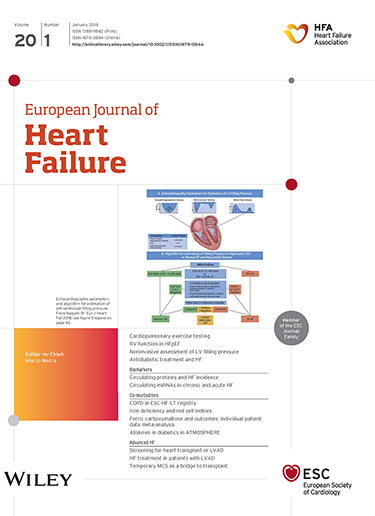心衰患者起始剂量5mg vericiguat的安全性和耐受性:VELOCITY研究
IF 10.8
1区 医学
Q1 CARDIAC & CARDIOVASCULAR SYSTEMS
引用次数: 0
摘要
目的:在临床实践中,简化药物滴定步骤的数量,同时保持安全性,可能会提高心力衰竭(HF)患者达到指南指导药物治疗(GDMT)目标剂量的可能性。VELOCITY研究考察了去除vericiguat起始剂量2.5 mg,改为起始剂量每日5mg是否安全且耐受性良好。方法和结果velocity是一项前瞻性、为期2周、单臂、开放标签的2b期研究,纳入了射血分数为45%、近期(≤6个月或≤6个月)HF (WHF)事件恶化或不恶化的慢性HF患者。排除收缩压≥100mmhg、近期有症状性低血压、近期背景GDMT或利尿剂剂量变化的患者。参与者开始服用每日5mg的vericiguat,并随访主要终点,定义为在第1次访问(第1天)和第2次访问(第14天)期间完成2周,最多中断1天,无中度至重度症状性低血压。在106例研究患者中(平均年龄67岁,28%为女性),50%近期有WHF。GDMT包括54%的处方血管紧张素受体-奈普利素抑制剂和81%的处方钠-葡萄糖共转运蛋白2抑制剂。93.4%的患者达到了主要耐受性终点,包括90.6%的WHF组患者和96.2%的非WHF组患者。起始剂量5mg的耐受性在预先指定的敏感性和次要终点之间基本一致。当比较VICTORIA组每日使用vericiguat 2.5 mg和VELOCITY组每日使用vericiguat 5 mg的患者时,VICTORIA组达到VELOCITY主要耐受终点的比例为97.2%,VELOCITY组为93.4%。结论:在一项针对射血分数为45%的慢性心力衰竭患者的前瞻性VELOCITY研究中,接受背景GDMT治疗的10例患者中有9例安全耐受起始剂量为5mg /d的vericiguat。无论最近的WHF史如何,结果总体上是一致的。在先前vericiguat研究的安全性和耐受性数据的背景下,VELOCITY支持临床指南的潜在更新,包括在近期无低血压的患者中起始剂量为5mg的vericiguat。临床试验注册:ClinicalTrials.gov NCT06195930。本文章由计算机程序翻译,如有差异,请以英文原文为准。
Safety and tolerability of a 5 mg starting dose of vericiguat among patients with heart failure: The VELOCITY study
AimsIn clinical practice, simplifying the number of medication titration steps while maintaining safety may improve the likelihood of patients with heart failure (HF) achieving target doses of guideline‐directed medical therapy (GDMT). The VELOCITY study examined whether removing the 2.5 mg initiation step for vericiguat, and instead initiating therapy at 5 mg daily, would be safe and well‐tolerated.Methods and resultsVELOCITY was a prospective, 2‐week, single‐arm, open‐label phase 2b study that enrolled patients with chronic HF with ejection fraction <45%, with or without a recent (≤6 or >6 months) worsening HF (WHF) event. Patients with systolic blood pressure <100 mmHg, recent symptomatic hypotension, and recent change in background GDMT or diuretic dosing were excluded. Participants were initiated on vericiguat 5 mg daily and followed for the primary endpoint, defined as completion of 2‐week period with maximum 1‐day interruption and without moderate to severe symptomatic hypotension between Visit 1 (Day 1) and Visit 2 (Day 14). Among 106 study patients (mean age 67 years, 28% female), 50% had recent WHF. Background GDMT included 54% prescribed angiotensin receptor–neprilysin inhibitors and 81% prescribed sodium–glucose cotransporter 2 inhibitors. The primary tolerability endpoint was met in 93.4% of patients, including 90.6% of patients in the WHF group and 96.2% of patients in the non‐WHF group. Tolerability of initiating vericiguat 5 mg was generally consistent across the pre‐specified sensitivity and secondary endpoints. When comparing patients initiating vericiguat 2.5 mg daily in VICTORIA with those starting vericiguat 5 mg daily in VELOCITY, the proportion meeting the VELOCITY primary tolerability endpoint was 97.2% in VICTORIA versus 93.4% in VELOCITY.ConclusionsIn the prospective VELOCITY study of patients with chronic HF with ejection fraction <45% who were well‐treated with background GDMT, >9 of 10 patients safely tolerated initiation of vericiguat at the 5 mg/day dose. Findings were generally consistent regardless of recent history of WHF. In the context of safety and tolerability data from prior vericiguat studies, VELOCITY supports a potential update in clinical guidance to include a 5 mg starting dose of vericiguat among patients without recent hypotension.Clinical Trials Registration: ClinicalTrials.gov NCT06195930.
求助全文
通过发布文献求助,成功后即可免费获取论文全文。
去求助
来源期刊

European Journal of Heart Failure
医学-心血管系统
CiteScore
27.30
自引率
11.50%
发文量
365
审稿时长
1 months
期刊介绍:
European Journal of Heart Failure is an international journal dedicated to advancing knowledge in the field of heart failure management. The journal publishes reviews and editorials aimed at improving understanding, prevention, investigation, and treatment of heart failure. It covers various disciplines such as molecular and cellular biology, pathology, physiology, electrophysiology, pharmacology, clinical sciences, social sciences, and population sciences. The journal welcomes submissions of manuscripts on basic, clinical, and population sciences, as well as original contributions on nursing, care of the elderly, primary care, health economics, and other related specialist fields. It is published monthly and has a readership that includes cardiologists, emergency room physicians, intensivists, internists, general physicians, cardiac nurses, diabetologists, epidemiologists, basic scientists focusing on cardiovascular research, and those working in rehabilitation. The journal is abstracted and indexed in various databases such as Academic Search, Embase, MEDLINE/PubMed, and Science Citation Index.
 求助内容:
求助内容: 应助结果提醒方式:
应助结果提醒方式:


